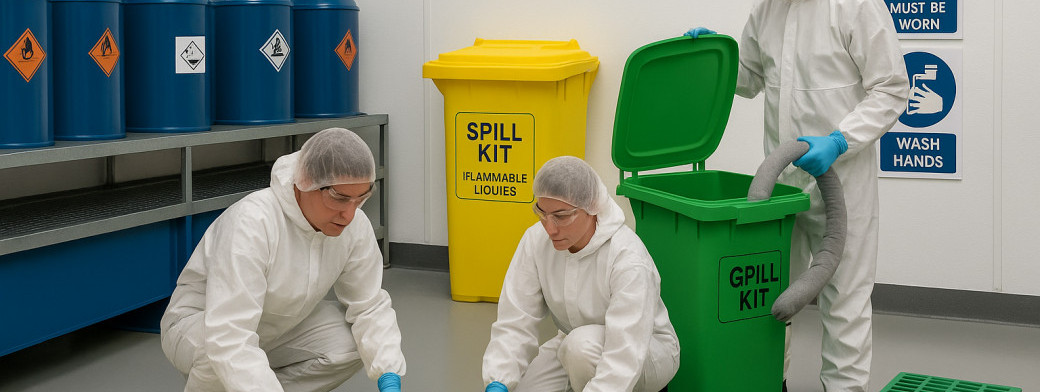
Spill Control in Cosmetics Manufacturing: Managing Oils, Fragrances and Pigments
In the cosmetics manufacturing sector, effective spill control is not just a regulatory requirement but a critical operational necessity. With the handling of oils, pigments, fragrances, and solvents, the risks associated with spills can lead to contamination, slip hazards, flammable conditions, and environmental non-compliance. Moreover, the integrity of your brand can be compromised by improper spill management. For comprehensive background on workplace risks, refer to the HSE – Cosmetic Industry Health & Safety Guidance.
Regulatory Backdrop
Cosmetics manufacturers in the UK must adhere to the Control of Substances Hazardous to Health (COSHH) regulations, ensuring the safe handling of hazardous substances. Additionally, compliance with the retained EU Cosmetics Regulation (EC) No 1223/2009 is essential. The Environment Agency’s expectations on spill prevention further underline the necessity for robust site-specific spill prevention measures within Good Manufacturing Practice (GMP) and audit systems.
Hazard Mapping
Understanding the sources of spills in cosmetics manufacturing is vital. Common materials that pose spill risks include:
- Fragrance oils
- Essential oils
- Surfactants
- Solvents
- Colour pigments
- Alcohols
- Preservatives
- Cleaning chemicals
Spills can occur in various locations such as mixing vessels, filling lines, pump transfers, packaging areas, and warehouse spaces. It is critical to identify flammable liquid zones and ensure adequate ventilation in these areas.
Controls
Implementing the right controls can significantly mitigate spill risks:
- Utilise colour-coded, low-lint absorbents and wipes made with natural fibres, suitable for hygienic environments.
- Incorporate bunded pallets, drip trays, and sealed chemical cabinets for the storage of solvents and fragrances. Refer to the Environment Agency chemical storage guidance for further details.
- Employ earthing and anti-static mats in areas where flammable materials are used, and provide solvent-safe Personal Protective Equipment (PPE).
- Establish spill kit zoning based on risk factors in areas such as mixing zones, warehouses, solvent storage, and finished goods.
Kit Strategy
Selecting the appropriate spill kit type based on the materials being handled is essential:
- Oil-only kits are designed for hydrocarbons.
- Universal kits work well for water and solvent mixtures.
- Chemical spill kits are necessary for corrosive substances.
Ensure correct kit sizing and strategic placement to optimise response times. Regular inspection routines and stock control should be maintained using checklists.
Procedures & Training
First-response actions in the event of a spill should follow these steps:
- Stop the source of the spill.
- Contain the spill using appropriate methods.
- Clean the area using designated absorbents.
- Document the incident thoroughly.
Staff should be trained to be aware of cross-contamination risks and ignition source control. Documentation practices should include near-miss reports, cleaning validation, and updates to COSHH logs.
Waste & Evidence
Proper disposal of used absorbents is critical. Utilise licensed waste contractors in line with the Environment Agency hazardous waste guidance. Ensure segregation between hazardous solvent residues and general waste to maintain compliance. Familiarise yourself with the “Duty of Care” waste documentation.
Practical Tools
To enhance your spill response capabilities, consider implementing the following templates:
- Spill Response Checklist
- Daily Spill Kit Audit Sheet
Case Study
Consider a scenario where a fragrance oil spill occurs in a filling area, posing threats of cross-contamination and slip hazards. Prior to implementing effective spill kits and staff training, the area faced frequent incidents that disrupted production and raised safety concerns. After introducing tailored spill kits and conducting training sessions, the facility reported a significant reduction in spill incidents, improved response times, and enhanced overall safety standards.
FAQs
- Which absorbents are best for cosmetic oils and fragrances? Low-lint absorbents made from natural fibres are ideal for these materials.
- Can oil-only kits handle perfume alcohol spills? It is advisable to use chemical spill kits specifically designed for alcohols to ensure effective containment.
- How often should solvent spill kits be replaced? Kits should be inspected regularly and replaced as required, typically according to usage and manufacturer guidelines.
- How should contaminated absorbents be stored before collection? Store absorbents in clearly marked containers away from ignition sources until collected by licensed contractors.
- What’s the best way to prevent pigment dust contamination after cleanup? Use damp cleaning methods and vacuum systems equipped with HEPA filters to minimise airborne particles.
Conclusion
Implementing effective spill control measures not only ensures compliance with regulatory obligations but also enhances workplace safety and brand integrity. An audit-ready approach to spill management can significantly reduce risks associated with hazardous materials. Discover our full range of Spill Kits for Cosmetics Manufacturing designed for solvent, oil, and pigment handling.
References
- HSE – Cosmetic Industry Health & Safety Guidance
- Control of Substances Hazardous to Health (COSHH)
- EU Cosmetics Regulation (EC) No 1223/2009
- Environment Agency chemical storage guidance
- Environment Agency hazardous waste guidance
DALL·E Infographic Prompt: Create an infographic themed around a UK cosmetics manufacturing facility, showing staff in PPE cleaning a fragrance oil spill, using low-lint absorbents, colour-coded spill kits, bunded solvent storage, drain covers, and GMP-style hygiene signage. The style should be clean and modern.
